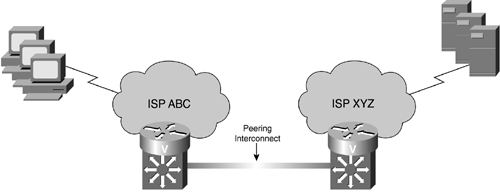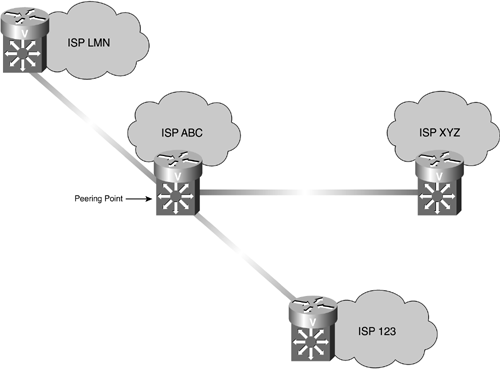Peering
Peering is a relationship between two or more Internet Service Providers (ISPs) in which the ISPs create a direct link and agree to forward each other's packets across this link instead of using the public Internet backbone (see Figure 20-3).
Figure 20-3. Peering Interconnect between Two ISPs

Suppose that a client of ISP ABC wants to access a web site hosted by ISP XYZ. If ABC and XYZ have a peering relationship, the IP packets travel across the direct connection between the two ISPs.
These peering interconnections result in more efficient access because there are fewer hops between client and server. These peering interconnections are more economical because the ISPs do not need to pay fees to a third-party network service provider (NSP).
Peering can involve more than two ISPs, in which case all traffic destined for any of the ISPs is first routed to a central exchange, or peering point, and then forwarded to the final destination, as illustrated in Figure 20-4.
Figure 20-4. NSP Peering Point

This peering point operation is similar to, but on a smaller scale than, the Network Access Points (NAPs) managed by the NSPs. These peering points can be made across dedicated facilities, such as Synchronous Optical Network (SONET) or Dense Wavelength Division Multiplexing (DWDM), or cross-connected in co-located equipment rooms.
Peering Points
There are four official NAPs, considered the "heart" of the Internet. These four NAPs are as follows:
San Francisco, CA
Chicago, IL
Washington, DC
Pennsauken, NJ
These four NAPs establish the model that any network interconnected with at least one of these points can be interconnected with the rest of the public Internet. Private backbone operators or network service providers are not inclined to share customers by connecting their customers to another NSP.
The NSP customer requirement to be connected to the Internet forces the commercial network service providers to address network interconnection. The National Science Foundation (NSF) defined the interconnection model by defining the Internet through its backbone and NAPs.
Metropolitan Fiber Systems, Inc. operates a series of Metropolitan Area Exchange (MAE) systems in large metropolitan areas across the country. MFS operates MAEs in San Jose (MAE West), Los Angeles (MAE LA), Dallas (MAE Dallas), and Chicago (MAE Chicago). MFS has two MAEs in Washington, D.C., the existing 10Mbps Ethernet MAE East, and a higher-speed 100Mbps Ethernet referred to as MAE East+. The two MAE-East NAPs and MAE West are de facto NAPs.
NOTESince the founding of the MAEs, MFS has been redefined through being acquired by UUNET in 1996. Since then, UUNET was in turn acquired by WorldCom, which also acquired MCI (in 1998). |
The NAPs can be considered the "top" of the Internet, the heart of the Internet, or sometimes the "sweet spot of interconnection." The NAPs have also become the bottleneck of the Internet, however, not meeting the bandwidth of Quality of Service (QoS) demands of end-users. Some network service providers have been deploying more private peering points, and other NSPs are developing private NAPs and selling connectivity to those NAPs to divest themselves from the public peering points.
EAN: 2147483647
Pages: 269